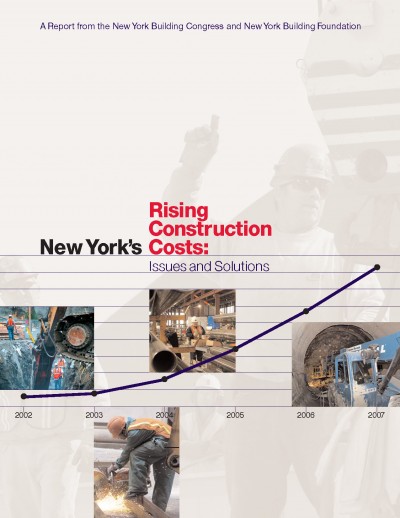
New York's Rising Construction Costs: Issues and Solutions
New York City Trends & Outlook
Over the past 35 years, the cost of construction in New York City has increased more than 400 percent, significantly outpacing overall cost increases in other large U.S. cities. In recent years, the cost curve has accelerated, with general contractors reporting a five to six percent increase in New York City in 2004, an eight to 10 percent increase in 2005 and a 12 percent increase in 2006. The current rate of one percent escalation per month moderated somewhat to an 11 percent yearly gain by the end of 2007.
Faster escalation in New York is widening the cost breach and hindering the City’s cost competitiveness against other U.S. cities. At present, construction in New York City is over 60 percent more expensive than comparable construction in Dallas, nearly 50 percent more than Atlanta, 25 percent more than Seattle and 20 percent more than Los Angeles.
Though subject to the same national and global trends in construction costs as these other U.S. cities, New York City has experienced greater increases in hard and soft costs due to its unique environment and cost factors. Leading the list, land costs have accelerated beyond all other cost factors, driven by high returns and rents in the luxury condominium and office markets of New York. Limited available sites, costs of environmental mitigation and the constraints imposed by public processes and regulations, such as zoning codes and site and design approval, also have contributed to high and escalating land prices. In Manhattan, developable land costs have risen several hundred percent in recent years to reported prices of $400 per gross square foot (gsf) of buildable floor area, with air rights offered at 50 to 60 percent of land costs. Desirable locations in the other boroughs, moreover, can now command $150-$200 per gsf, prices that, until recently, had been attributable only to Manhattan.
Apart from the market forces over which it has little control, New York has self-inflicted significant cost escalation through certain public sector and industry practices and regulatory requirements. Procurement rules and processes that fail to allocate risk fairly and appropriately to the party that controls the risk, along with delays in the close-out and payment process, produce higher bids on projects and have a chilling effect on competition. Subcontractors report adding as much as 20 percent to General Conditions on bids for public projects to cover costs associated with their risk exposure and government inefficiencies. A leading example of inappropriate risk allocation that inflates contingencies involves the “No Damages for Delay” provision. Contained in several public agency contracts, this provision prohibits the contractor from recovering reasonable increased costs for owner-caused delay. This increases the costs of construction because knowledgeable contractors automatically build the risk of delay into their bids, ensuring that government pays for potential delays whether they occur or not.
Public and private owners also pay a price for their part in tightening the cash flow of subcontractors. Already affected by the high volume of Citywide building activity, subcontractor cash flow is further squeezed when money is tied up in change orders and retainage requirements. Due to owner delay in processing payments and closing out jobs - as well as the lack of upfront mobilization payments - subcontractors may have insufficient funds to start or continue working on a project.
This can lead to delays that contribute to increased construction costs. Payments made within 30 days can reportedly generate a three to four percent savings on the hard costs of all trades, whereas on mega-projects, prompt payments could result in a savings of as much as eight percent on the hard costs of certain trades.
Poor project planning and management, particularly in the public sector, create inefficiencies that also contribute to increased costs. Inefficiencies arise from a range of project management issues, including the lack of clarity of scoping documents and drawings, changes to scoping and specifications, delays in decision-making and insufficient budget accountability. In addition, New York’s increased enthusiasm for high design and “starchitects” comes with greater risk of ballooning costs for those owners, especially public owners, that lack the capacity to manage the design process, value engineer and control costs on complex projects.
Comparatively higher insurance rates and liabilities and a limited supply of local specialized trades, like curtain-wall installers and elevator/structural steel erectors, make building in New York more expensive, as do urban logistical issues like street congestion, special permitting requirements for Saturday deliveries and staging constraints, which add to delays and material transport costs.
Finally, New York’s higher prevailing wages, more extensive union work rules and jurisdictional issues can also contribute to higher costs through delays caused by different work schedules among various trades and the jurisdictional settlement process for dealing with the division of labor between trades. Delays caused by productivity and work quality issues related to less-skilled, less-experienced non-union labor can be another contributing factor.
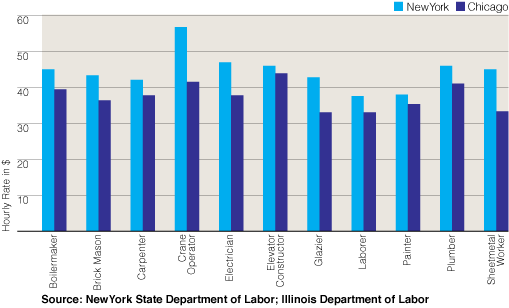 |
To follow are brief summaries of cost escalation in three categories of New York City’s non-residential construction sector: office, institutional and infrastructure. Each is based on extensive interviews with industry participants, as well as independent research. Also included are recommendations on steps that government, public and private owners, management and labor can take to contain and even reduce construction costs.
Office Construction
In 2007, the hard costs of constructing a high-rise New York City office building ranged between $285 and $375 psf, compared to a $230 psf average in 2003 and roughly $120 to $130 psf in the mid-1990s. Today’s costs represent a 50 percent increase from four years ago and reflect a 150 percent differential over the hard costs for a comparable office building in Chicago. When contingencies, general conditions, insurance, subcontractor bonds and construction management fees are added, the total project costs for high-rise office buildings in New York can exceed $400 psf – exclusive of soft costs, land costs and developer profits. By contrast, total project costs can average $150 psf in Atlanta, $180 psf in Chicago and $200 to $300 psf in other major cities.
| Prime Office Building Construction Cost Range, 2007 |
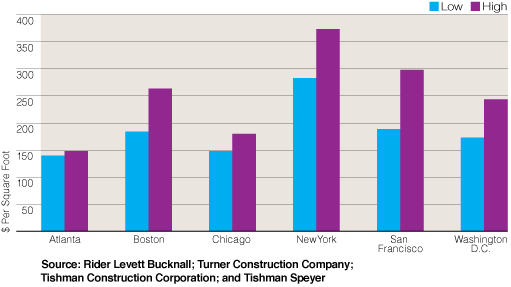 |
In January 2008, the Bureau of Labor Statistics estimated a 3.3 percent increase in office building construction costs nationally over 2007. By comparison, major New York contractors currently report a 10 to 12 percent increase in the City and foresee a decade of substantial construction demand with continued cost escalation over the next five to six years. The contributing factors most often cited include:
- fewer concrete, steel, curtain wall and elevator subcontractors to accommodate an increasing amount of public and private work;
- long lead times on materials, ranging upwards from two months for concrete, eight months for steel and 12 months for curtain wall and elevator trades, compounded by volatility in global market prices and fuel-related escalation in local commodities;
- delays in payments or owner approvals that disrupt production schedules, such as mill slots, and impose further costs for trades; and
- shortages in project managers, skilled foremen and laborers, with associated productivity issues and rising overtime costs.
Certainly, many factors unique to New York affect its costs. Proximity to subways, the depth of rock, a dense urban fabric, confined sites, the presence of previous and adjacent structures, and the size and risk associated with large-scale projects present complexities that layer on costs. The decrease in the number of specialized trade vendors, even though many subcontractor jobs now exceed $100 million in value, exemplifies the risks inherent in this high-pressure market.
The evolution of building design and new building code requirements also contribute to rising office costs. Structures and facades are built today for added security and anti-terrorism impacts and, thus, often rely on emerging technology, requiring more sophisticated and higher capacity mechanical and electrical systems. The recent trend toward architecturally distinct and environmentally sustainable facilities additionally contributes to increased building costs.
Institutional Building
As a general rule, institutional facilities tend to cost more to construct than office buildings. This sector, which encompasses schools, hospitals, museums, court houses and other public assembly structures, lacks the repetitive template of residential and office structures, making development considerably more complex. Many of these buildings vary between floors, which can differ in use, format, ceiling height and electrical requirements. Most must also contend with more costly regulations and other non-structural inspection requirements, such as health care safety.
Often, private institutional clients face eroding resources and constrained budgets that fail to match original design concepts. Timelines can stretch as long as 10 years, with project costs revised throughout. Because funds are held back longer, contractors tend to add points to contingency percentages in construction budgets to cover expected and impending delays, whereas a prompt payment policy might yield significant savings on hard costs.
Some progressive measures to increase productivity and reduce costs have been made by union labor through the use of project labor agreements (PLAs) on private and public works projects. Perhaps the best example of this trend in the public sector is the PLA with the New York City School Construction Authority (SCA), which is generating $488 million in savings on more than $6.7 billion worth of improvements to existing educational facilities.
School Building: The national average cost of constructing new public elementary and high schools rose seven percent in 2006 and 11.6 percent in 2007, according to the Bureau of Labor Statistics. With a $13 billion capital plan that assumes five percent annual inflation, the SCA has experienced escalating costs at bid for all new capacity projects. Over the 2005-2009 period, the SCA anticipates building 100 new schools by a low-bid process. As of 2007, new school construction averaged $433 psf, or nearly 15 percent above 2006 and 33 percent more than the design standard set at $325 in 2003.
The SCA has recently relieved some pressure on subcontractor costs by revising change order provisions in its contracts. Progress payments will now be made for up to 80 percent of estimated costs, as determined by the SCA, on an allowance change order of $50,000 or more. Within 90 days from the date of the notice of direction, a contractor must submit a detailed cost proposal, whereupon a fair and reasonable evaluation of costs will be completed by the SCA and a final amount will be negotiated with the contractor. This reform, which addresses the payment delays and uncertainties that have led contractors to inflate public sector bids, has been well received and should result in public savings.
In the private sector, prompt payment is less of an issue, but project costs are typically greater. According to Tishman Construction Corporation, the hard costs of school construction set at market rate in 2007 were $512 psf in New York and $289 psf in Chicago. Four components – plumbing, HVAC, electrical and exterior façade – account for 69 percent of the trade cost difference. The SCA attributes recent cost escalation, including price increases for certain materials, to increased competition for building resources due to New York’s hot construction market. Concrete costs, for example, rose 10 percent in 2006 alone.
| New York City School Construction Authority Construction Payments &Costs Per Square Foot |
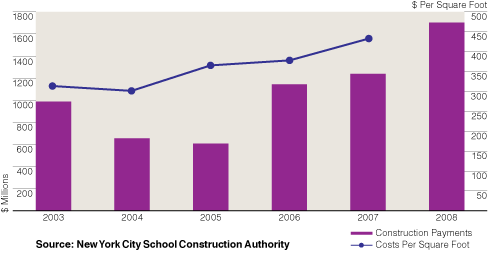 |
Hospital Building: The cost of hospital construction currently averages $600 psf in New York City, which is considerably more than high-range construction costs of general hospitals in other major U.S cities. In Boston and Washington D.C., for example, hospital building costs range from $500 to $555 psf, while in Los Angeles and San Francisco costs range from $380 to $400 psf.
Even though the superior quality of its major teaching hospitals and specialized centers of health care may explain a cost differential over general hospitals elsewhere, costs are rising rapidly in New York. The cost of new hospital construction is up 12 percent per year, while renovation and alteration costs are escalating at roughly six percent per year. Nevertheless, the need to accommodate cutting-edge technology and to keep abreast of conditions in competing hospitals means that expansions and renovations are not deferred, only scaled back if necessary. Volatile material prices, not labor, are considered to be the major cause of escalating hospital construction costs.
Infrastructure2
Comprising more than half of all construction spending in New York City, infrastructure projects undertaken by State and local government agencies using their own funding resources and/or intergovernmental aid are implemented by negotiated procurement or low-bid processes. Initially, these projects are identified in capital budgets that typically array maintenance and expansion projects over a five-year timeframe, guided by a strategic plan of action. Agencies estimate future project costs on a labor and materials basis and factor in multi-year rates of escalation that reflect cost trends, labor negotiations and commodity forecasts. For example, in conducting its analysis, the Metropolitan Transportation Authority (MTA) assumes a 10 percent annual increase in labor costs due to the combined effect of prevailing wage increases and a shortage of skilled labor.
| MTA Capital Construction: New York Steel Prices |
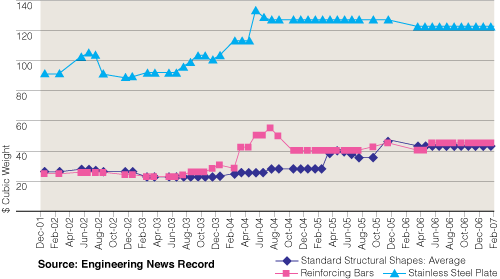 |
The costs of heavy infrastructure projects, such as tunneling, are more affected by workforce issues and government practices and requirements than by material costs. This is because fewer exotic materials and subcontractors are used in infrastructure work, as compared to building construction. In addition, material cost escalation can be handled by change orders, with public agencies assuming the risk of volatility in commodity markets once contractors estimate material costs at current prices.
On the other hand, demand pressures caused by the extraordinary volume of construction activity have been straining the available workforce, compromising job productivity and efficiency. Increased overtime to meet demand has further contributed to rising labor costs. The shortage of skilled labor, for example, has led contractors to resort to less experienced “B” and “C” teams, when more experienced “A” teams are no longer available, yielding a measurable rise in labor inefficiency. Project management skills have also been stretched thin, allowing less time for, and emphasis on, comprehensive planning at the beginning of a project. In turn, less time and emphasis on the planning stage of a project have affected the timely and accurate procurement, purchase and delivery of materials and services, resulting in less job productivity and increased risk to contractors.
A number of public sector practices and requirements also pose substantial risks to private builders, forcing them to increase bids in order to cover potential costs. The “No Damages for Delay” provision in some public agency infrastructure contracts is an example of the kind of risk private builders account for in their bids. In addition, a public agency’s shortage of engineers, unfamiliarity with union rules and regulations and failure to produce complete drawings at the start of work can mean potential lawsuits or years of delay in closing out projects, ultimately translating into added costs.
The consequences of failing to address these kinds of risks can be dire. In years past, heavy construction capacity was reduced by a lack of contractors in New York, as volatility and excessive risk-taking led to the bankruptcy of major contractors.
Avoiding that outcome in the future will require more than risk reallocation and reduced regulatory burdens, such as the relaxation of surety bond requirements, which has already been done to help relieve cost pressures and induce more bidding in New York’s robust construction market. Maintaining and expanding infrastructure systems in a world class city will also require more highly skilled engineeringbased construction companies that are willing and able to partner with public agencies that have enhanced management and internal design capacity.
2Given the range of infrastructure projects – from tunnels and roadways to airports and utilities, comparative cost analyses are difficult to produce from year-to-year. The Bureau of Labor Statistics provides an important national indicator of commodity and industry inflation with its preparation of the Producer Price Index (PPI), a companion to the Consumer Price Index (CPI). Historically focused on energy and raw material prices, the Bureau has recently addressed the need for measuring change in the cost of construction by building type. To date, however, only price changes for office buildings, school buildings and warehouses have been tracked on a monthly basis. With respect to infrastructure, the Bureau measures the national cost increase in highway and street construction, which has escalated by 50 percent since 2004. Expansion of the Bureau’s program to other building types, as well as to a variety of non-building infrastructure components, would greatly broaden our understanding of cost pressures in the national economy and enhance the ability of policymakers to contain inflationary forces.



